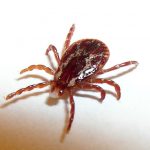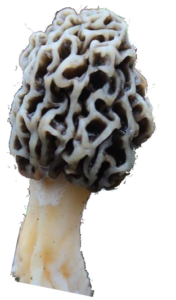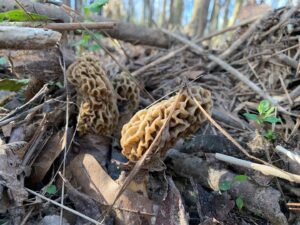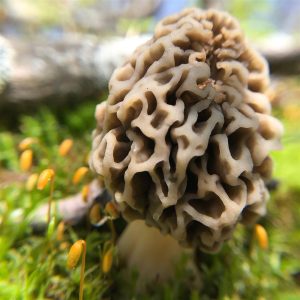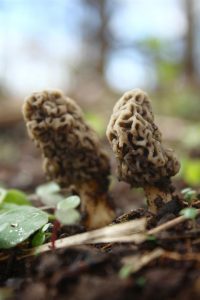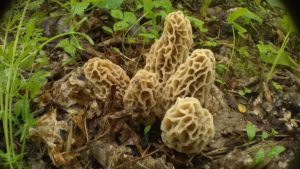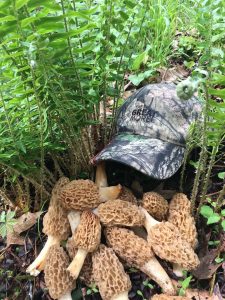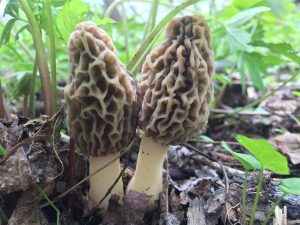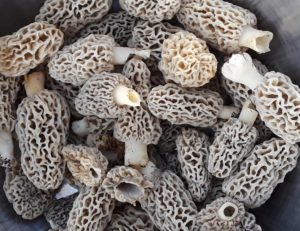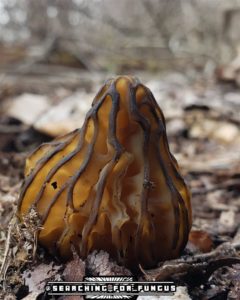Before you head into the woods in search of the ever elusive morel, browse this page for some pretty good advice and things to keep in mind when you are out there. Here you will find a few suggestions and tips on how to avoid and minimize the risks sometimes associated with being in the woods seeking the morel. Yeah that’s right – there are risk we all take so don’t laugh. Things such as ticks, poison ivy, and making sure you are properly geared up.
- Take care of your feet – Foot support is critical as you will encounter all kinds of terrain so it is important to wrap your feet in good quality foot wear. Get yourself a good pair of boots that are well fitted. Wear an ankle height boot for added support and always wear a quality pair of socks. Taking care of the feet is an important start to your foraging adventure.
- Get yourself a good walking or hiking stick. You would be surprised how useful your walking stick will be. Not only for additional support but it can be used to move lower vegetation to help you find those hidden morels. Let’s not forget to mention if you get yourself in a patch of briars you can use it to help navigate the mess you just got yourself into. If you are in need of a good hiking/walking stick, slip on over to The Great Morel Store and pick one out.
- Tick Protective. Enough cannot be said on these nasty little insects, which is why there is a section below specifically dedicated to tick prevention and awareness.
- Know your poison ivy plants. Many of us already know what these plants are and how to avoid them but for those who don’t there is a pretty good section below that is worth the time.
- Use good gear. Okay this is a promo for gear, so make sure you hit the Morel Store before you head out and get yourself whatever gear you need.
Let’s get started with the little pesky insect we all should be wary of…the tick.
Avoid the Ticks
Most morel hunters know the serious danger these little creatures can cause for those who don’t use protection. The word ticks should make us all be put on alert. Ticks are known to carry Lyme Disease – a word of warning: Lyme Disease is no fun. Understanding how to protect and prevent ticks is vital to anyone who heads out looking for morels. Learn to protect yourself. Learn about it – the tick.
While there are over twenty (20) species of ticks, there are primarily only four of which most of us will come in contact with – the American Dog Tick, the Deer (or Black Legged) Tick, the Brown Dog Tick, and the Lone Star Tick. There are health risks associated with each of these so it is good to be able to identify and understand what the risks are. There are a couple links below to help us all.
Enlarged image of a Wood Tick. Photo courtesy of Ben Stallman – Lake of the Woods, MN.
A good pre-foraging practice is to make sure you treat your clothing and body with a tick repellent of some type. Repellents can be both handmade or most of your bug repellents offer a tick repellent. When you get done harvesting your morels, make sure you give yourself a good tick check – checking your hair, ears, and other body parts as well.A good homemade recipe tick repellent for on your clothes and your pets follows (from the USDA forest service):
- 2 cups white vinegar
- 1 cup Avon skin so soft bath oil
- 1 cup water
- 1 tablespoon eucalyptus oil.
- Put this mixture in an old spray bottle. No guarantees but it works for some with success.
If you haven’t been told yet and you live in an area with ticks like we do in Kentucky, put fabric softener sheets in each sock and a couple in your back pockets and you won’t have the tick problem. Works like a charm. Happy hunting! – Courtesy of Annie in Kentucky.
If you would like more information on ticks, check out TickInfo.com for what maybe the most resourceful tick site on the Internet.Read more here from the Midwest Pesticide Action Organization
If you would like to read more on Lyme Disease click here and read this PDF version of an e-mail from Nancy Bishop.
http://thegreatmorel.com/lyme.txt
The dreadful poison foliage
Before you reach down and start harvesting that nice patch of morels make sure you are not inserting your hand into a mess of poison ivy. We all have probably done this at one point or another so take the time and see who the morel has chosen as a neighbor.
Here is a link to the Poison-Ivy.org website which is a great resource for everyone. It will enlighten everyone on the various vegetation to be wary of. Well worth the visit just in case you are not familiar with all the various types and their geographical locations.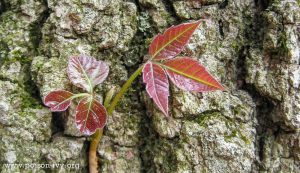
There are lots of products out on the market for pre and post contact with the poisonous foliage. If one has ever had a bad case of the rash, you’ll learn in a hurry to practice a simple three part technique: identify, avoid and avoid some more! If any of these three guidelines are not followed then you’ll be heading to the drug store for some post contact ointment or spray.
Another great resource to help understand the various poison vegetation you may encounter is CampingCooks.com – they have a wonderful article on “Poison Ivy Prevention & Treatment: How to Stay Safe When Encountering Poison Ivy, Oak, & Sumac“. A really great site and well worth a visit for additional education!
Below is a contribution from a fellow shroomer on the use of Jewel weed. Now The Great Morel doesn’t know very much about Jewel Weed, so it is suggested to read on.
Poison Ivy and Jewel Weed – contributed by Lee Brewer
Also, a bit of help to post for the hunters. If they learn what Jewel Weed is (spotted-touch-me-not), they will learn that if they get into poison ivy/oak, all they have to do is find some Jewel Weed, crush the stem, and apply the juice. most of the time the poison will not even show up after Jewel Weed has been applied! It will prevent ivy from taking hold. To prove this I have deliberately picked poison ivy, spread it on my arm, and then applied Jewel Weed – no trace of the poison shows itself! This is a remedy that works better than any store-bought medicine I have ever seen. In fact it supplanted our use of store bought med’s at a former camp I used to be the director of. Just Google “Jewel Weed” and you will be able to get pictures, etc.
If you find some and apply it, pick some more to carry some pieces of stalk in your shirt pocket. Then apply to the same area whenever you think about it. Most of the time I have seen one application CURE the poison. However, for good measure, plan on two or three applications. the Jewel Weed “juice” is not sticky, smelly, or noticeable.
Jewel Weed can have either orange, yellow, or (allegedly) purple flowers (I have read purple is supposed to be in Ontario and Northward although I have never found it there). Yellow seems to be a more southern variety (below Northern PA) and quite as potent as orange. The boiled juice can be frozen to preserve it and refrigerated after thaw/use. But watch it carefully as the refrigerated stuff deteriorates quickly and I have found it to grow mold on top within a few days. Hence, until recently, this forgotten cure stayed a part of our domesticated medicine cabinets. It does not seem to grow in the deep south – but I once did find a jewel-weed like plant in SC by a stream. The stem was the same, the roots were the same, the leaves were similar. It was not as potent, but still worked well enough that it made store meds pale.
Oops – I just Google’d Jewel Weed! I see now they finally have found a way to preserve it in a medicine. I do not know how well these store/ internet bought Jewel Weed med’s work, but since people ‘shroom hunters are out in the woods anyway, and Jewel Weed it is a common plant in a lot of areas (likes damp soil – almost always along stream- beds – a lot of the time very close to poison ivy!) – they may as well save the $$, pick it, crush the stems it, and apply right there.
If someone has poison badly enough for blisters, I literally have cured it overnight by bandaging a split stem of the Jewel Weed right on top of the blister. You can also pick a good amount of it – about a bundle 5 inches in diameter, boil it (leaves and all), dump the colored liquid into a bathtub of water, boil the same batch again and add the boiled water to the bath again. Orange Jewel Weed makes an orangy-brown liquid. I am not sure about yellow etc. Now get in the tub, and as long as the infected area is under water you can scratch it until it stops itching (AAAAAHHHHH! RELIEF!). The poison cannot spread while under the Jewel-Weed-diluted water. After your are done scratching (I have done it until I feel no itch at all in the area – under the water — I deliberately break open the bumps so the jewel- weed can get to the ivy’s oils and neutralize them so they cannot spread) you can take the infected area out of the water and will have no problem with that area of Ivy-rash again — well, until the next time your are out ‘shroomin, get into more ivy, and don’t apply Jewel Weed right away!
I have not found one person who is not amazed at the way that Jewel Weed works. It works so well on some people, like myself, that if I do accidently get into ivy, without knowing it, that I can hold a piece of split stem on one bump (or a small area) and it is gone yes – cured) in ten minutes. I know it seems a miracle cure – try it – it is! BTW, if you are a person who has gotten it internally from breathing smoke where someone was burning leaves (and poison ivy was in the batch!), this does work on the outside – but it will continue to re-surface in different areas. The Jewel Weed becomes a way of fixing the symptoms – since the ivy is in your system (instead of attacking the outside) until the ivy “runs its course.” I know this from experience – then only the Dr.’s Prednisone shots can cure it .
One more thing yet! IF you cannot find Jewel Weed – birch bark boiling and bathing (as above with Jewel Weed) can work also. If these are not available – supposedly boiling acorns to get their tannic acid out of them – then bathing – also works. I have used the birch bark method – and it works – not quite as well as Jewel Weed – but again, better than Calamine, Ivy Itch, and the powerful, so-called ivy-oil-locking meds I have tried. I have never tried the Jewel-Weed derived store-bought med’s. Maybe someone else can enlighten us?
Hope this helps out with the itches!
– contributed by Lee Brewer near Hagerstown Maryland.
Additional Information and Resources

